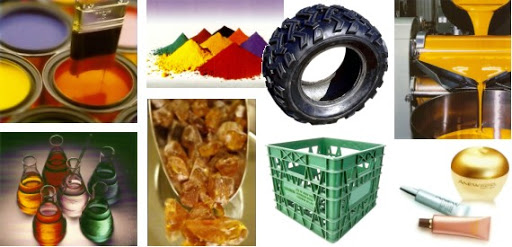Resins
HYDROCARBON RESIN – Hydrocarbon resins are amorphous thermoplastic polymers produced by polymerization of unsaturated hydrocarbons. There are three main types of Hydrocarbon resins C5 aliphatic, C9 aromatic, and DCPD cycloaliphatic resins. They are sometimes hydrogenated to reduce discoloration and to improve their heat and UV stability.
GUM ROSIN/WOOD ROSIN – Gum Rosin, also called colophony or Greek pitch, is a solid form of Pine oleoresin from pine trees, mostly conifers, produced by heating fresh liquid resin. Gum rosin is used as a softening agent to make the rubber soft and easy for kneading, make the filling agent easily dispersed. Gum Rosin can be used as a glazing agent in medicines and chewing gum. It is denoted by E number E915.
PETROLIUM RESIN- Petroleum resins are used to provide chemical resistance, adhesion,and pressure resistance properties in these industries. Petroleum resins are used in adhesives & sealants, paints & coatings , rubber compounding, printing inks, and others applications.
PF RESIN- Phenol formaldehyde (PF) resin is widely used as coating, adhesive, and foam material due to its many advantages, such as the good mechanical and electrical insulation property, durability, and heat and flame resistance, producing low amounts of smoke during burning
CI RESIN – C.I. Resin finds it is used in the manufacture of the resin slabs for floor, linoleum, glues, adhesive insulating tape, artificial leather, as a binder in the manufacture of abrasive tools, as impregnation for paper & textiles to ensure water resistance.
SYNTHETIC RESINS:
Synthetic Resins are typically viscous substances that convert into rigid polymers through a curing process. Resins are naturally occurring but are now often made synthetically. Some synthetic resins have similar properties to natural plant resins, but many are very different.
Synthetic resins have several classes.
Polyester Resins
Polyester resins are formed from the reaction of dibasic organic acids and polyhydric alcohols. They are very flexible and have excellent resistance to heat, chemicals, and flame. They tend to be low cost. They are used for construction, laminate, auto-repair of fillers, skis, fishing rods, plane and ship components, coatings, decorative accessories, and bottles.
Phenolic Resins
Phenolic resins are a type of thermosetting resin. They are strong, heat and impact resistant and have a high resistance to chemical corrosion and the penetration of moisture. Phenolic resins are machined easily. They are used for resin impregnation, brake linings, electrical components, laminate, adhesives for cement, bonded adhesives, and molds.
Alkyd Resins
Alkyd resins are thermoplastic polyester resins created by heating polyhydric alcohols with polybasic acids. They have excellent electrical and thermal properties and good chemical resistance. They are low cost and used for electrical insulation, electronic components, putty fillers, and paints.
Polycarbonate Resins
Polycarbonate resins are thermoplastics generally developed from bisphenol A and phosgene. They have a high refractive index, electrical and thermal dimensional stability, resistance to staining, and resistance to filtration. They are used for metal replacements, safety helmets, lenses, electrical components, photography film, and insulators.
Polyamide Resins
Polyamide resins contain an amide group as a recurring part of their molecular chains. They are easily molded, strong and resistant, and lightweight. They have a low friction coefficient and are abrasion and chemical resistant. They are used for nonlubricated bearings, fibers, gears, sutures, tires, watchbands, packaging, and bottles.
Polyurethane Resins
Polyurethane resins are copolymers made up of polyol and isocyanate components. They are very versatile when combined with other resins, and have a high film elasticity and adhesion to substrates. Polyurethane resins also have a good balance of elongation and hardness. They are used for insulation, elastomers, adhesives, and foam liners for clothing.
Silicone Resins
Silicone resins used to be created with sodium silicate and various chlorosilanes, but now they are often formed with the less reactive tetraethoxysilane or ethyl polysilicate and several disiloxanes. They have good thermal and oxidative stability and are flexible and water repellent. Silicone resins form hard films because of their three-dimensional network structure. They are used for rubber, laminates, encapsulated resins, defoamers, and water-resistant applications.
Epoxy Resins
Epoxy resins, also called polyepoxides, are a type of reactive prepolymers and polymers which contain epoxide groups. They have excellent chemical and heat resistance and strong adhesion properties. They are used for laminates, adhesives, flooring, linings, propellers, and surface coatings.
Polyethylene Resins
Polyethylene resins are the most common type of resin, with over 100 million tons produced annually. They have strong chemical and steam or moisture resistance and a high degree of flexibility. They are used for packaging for laminates and films, containers, cable insulation, coatings, toys, molds, linings, and pipes and tubes.
Acrylic Resins
Acrylic resins are related thermoplastic or thermosetting plastic substances created from acrylic acid, methacrylic acid or other related compounds. They are clear with good tensile strength. Acrylic resins are impact and UV resistant. They are used for structural and decorative panels, adhesives, elastomers, coatings, signs, and translucent tiles.
Polystyrene Resins
Polystyrene resins are aromatic hydrocarbon polymers made from the monomer styrene. They are low cost and easy to produce, with excellent resistance to acids, alkalis, and salts. Polystyrene resins also have good clarity and flexibility. They are used for insulation, pipes, foams, cooling towers, rubber, automotive instruments, and dashboards.
Polypropylene Resins
Polypropylene resins are a type of thermoplastic polymer resin that does not contain BPA. They are colorless and tasteless, with a low density and good heat resistance. They can be sterilized, so they’re often used with medical equipment. Polypropylene resins also have good chemical resistance. They are used for toys, electronic components, pipe and production tubing, fibers and filaments, and coatings.
• HYDROCARBON RESIN
• GUM RESIN/WOOD RESIN
• PETROLIUM RESIN
• PF RESIN
• CI RESIN
• EPOXY RESIN

